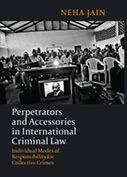Perpetrators and Accessories in International Criminal Law: Individual Modes of Responsibility for Collective Crimes

Author: Neha Jain
Publisher: Oxford, UK; Portland, OR: Hart Publishing, 2014. 250p.
Reviewer: Jens David Ohlin | September 2015
To the uninitiated, the subject matter of Neha Jain’s book might seem obscure. An entire book on the micro-doctrines applied to principals and accessories by international tribunals in The Hague? In this short review, I hope to convince the reader that Jain’s book is essential reading not just for scholars and students of international criminal justice, but for anyone who cares about how domestic criminal law—in any system—treats principals and accessories.
International tribunals usually reserve their scarce judicial resources for prosecuting higher-level defendants who are most responsible for the worst atrocities during a given conflict. However, these high-level defendants, usually military commanders or politicians, almost never personally commit the crimes by their own hand. Consequently, the most important doctrinal move for any international tribunal is to draw a tight conceptual connection between the defendant and the physical perpetrators. Furthermore, the connection needs to be rigorous enough that it withstands the scrutiny of criminal lawyers and scholars around the world. This is not easy, since different legal systems use different concepts to perform this linkage. Indeed, the brief history of international criminal law embodies a pendulum swinging between competing paradigms from different legal cultures.
Consider, for example, the various doctrines that can be used to distinguish between principals and accessories. Under the classic common law approach, the principal perpetrator is the one who performs the prohibited act, the actus reus; everyone else is a mere accomplice. (This approach is sometimes referred to as the “objective approach,” though that label may be more confusing than helpful.) Although this view dominates in the common law, it can produce implausible results, such as when Tony Soprano sends Furio to commit a murder. Furio is the principal perpetrator and Tony is a mere accomplice. Does this get their relative culpability correct? Arguably, it is backward.
In contrast, some jurisdictions define the principal as the individual with the culpable mental state—the intent to carry out the crime. (In contrast to the “objective approach,” this mens rea-based approach is sometimes referred to as a “subjective approach”). Although this seems more plausible than the actus reus approach, and indeed was widely applied by German courts for many decades, it was heavily criticized by German scholars after a series of extreme applications of it in a few bizarre cases.
Nonetheless, when the ad hoc tribunals began their work in the mid-1990s, they relied heavily on a subjective approach that focused on mens rea. The International Criminal Tribunal for the Former Yugoslavia (ICTY) applied a doctrine known as “Joint Criminal Enterprise” (JCE). This subjectivist theory allowed the court to prosecute as principals all members of the enterprise who shared the same criminal intent with regard to the common plan. This was called JCE I. Under an extended version of the theory known as JCE III, defendants who willingly participated in a common plan or endeavor to commit one international crime were responsible, again as principals, if others within the group strayed from the plan and committed a second, “reasonably foreseeable” crime. The extensive nature of this liability bore structural similarities to the American conspiracy doctrine famously announced in United States v. Pinkerton.
When the International Criminal Court (ICC) first started hearing cases, it declined to apply JCE as a mode of liability and instead adopted an entirely different conceptual structure known as the Control Theory of Perpetration. The Control Theory is relatively unknown to American criminal law scholars, but it is well received among scholars in the civil law tradition. Developed by the German criminal law theorist Claus Roxin, the Control Theory is designed to provide a third option for distinguishing between principals and accessories.
Roxin sought to develop a third way—the Control Theory—to break the logjam between the objective and subjective approaches. In short, the Control Theory dictates that the principal perpetrator is the person who controls whether or not the crime occurs. As such, Tony Soprano, as the mob boss, would be a principal because he “controlled” the crime. If two or more individuals are in this position, they are deemed co-perpetrators. If the person in control uses someone beneath him to carry out the crime, he is a principal as an indirect perpetrator (similar to the common law doctrine of perpetration by means).
For many years, Roxin’s Control Theory remained an academic theory. But it was applied by the German courts in the Border Guard Cases. After the fall of the Berlin Wall and reunification, the government of the newly unified nation decided to prosecute individuals responsible for the fatal shootings of civilians who attempted to flee to West Germany over the wall. The German courts were disturbed by the prospect that government officials behind the scenes, who ordered the shoot-to-kill policy, would be labeled as mere accomplices. Consequently, the court convicted East German leader Erich Honecker as a principal perpetrator using Roxin’s Control Theory of Perpetration.
The Control Theory of Perpetration was also adopted by the ICC in several early prosecutions in The Hague, and it is now the governing precedent at the international court. Unfortunately, the doctrine’s roots in German criminal law theory, much of which is published only in the German language, is difficult for non-German speakers to engage with. That’s why Jain’s book is so important. Jain has written several articles about modes of liability and Roxin’s Control Theory, and her new book is one of the few book-length treatments of the subject. Although the Control Theory was cited with approval by George Fletcher in Rethinking Criminal Law, and also discussed by Mark Osiel in Making Sense of Mass Atrocity and Elies van Sliedregt’s Individual Criminal Responsibility in International Law, the English-language secondary literature dealing with the nuts-and-bolts of this important theory is rather sparse. In that sense, Jain’s book is essential reading for anyone who cares about how international tribunals connect defendants to the physical perpetration of atrocities.
As for her normative positions, Jain lays out her own theory of perpetration for international crimes in chapter 8 of the book—the core of her argument. At the end of the day, she sides mostly with Roxin, and her own theory is largely a series of friendly amendments to Roxin’s position that tailor it more specifically to the international context, though she is careful to note that her modified position might “constitute a departure from settled principles of perpetration responsibility in both German and English criminal law (and by extension criminal law doctrine in other countries that are based on these systems).” (p. 150).
Specifically, Jain supports, with amendments, Roxin’s theory of Organisationsherrschaft, roughly translated as perpetration through an organized and hierarchical apparatus of power. It is a variation on indirect perpetration that Roxin was inspired to develop after watching the Eichmann trial in Israel. Under Organisationsherrschaft, a behind-the-scenes official could be deemed in control of the crime, and by extension the principal perpetrator, if he deployed an organization that carries out the physical perpetration of the international crime. In Roxin’s writings, the structure of these machine-like organizations was such that their members were fungible (interchangeable), i.e. any individual could be replaced if they became unavailable. Furthermore, the nature of these organizations was that they automatically carried out the orders of the leader—making them an instrument of the perpetrator’s will. Finally, such organizations needed to be “detached” from the law, i.e. operating outside of the legal system.
Jain disagrees with some of these requirements and develops her own modified version of Organisationsherrschaft that she believes is best suited for prosecutions at the ICC. The details here are less important than the overall message, which is that control is the relevant moral metric for distinguishing between principals and mere accomplices. Jain also offers a convincing account of the mental state required for conviction under this mode of liability. Following German law, Jain refers to the mental state requirement as one of “double intent,” i.e. intent “with respect to the elements of the offence in question, as well as in relation to the elements that enable him to establish his control over the act” (p. 145). In an important caveat (which perhaps ought to be expanded), Jain concludes that, at the very least, the perpetrator “must have knowledge of his position or authority that allows him to harness this apparatus for the ends he desires, and the atmosphere of moral permissibility for the crimes he wants” (p. 145, emphasis added). With this standard in mind, neither recklessness nor dolus eventualis (a civil law concept closely akin to recklessness) is sufficient to meet the standard. Consequently, Jain’s version of the theory is appropriately more rigorous than the JCE III doctrine applied at the ICTY, which allows prosecutors to charge defendants for a crime that was reasonably foreseeable, even if the elements of the offense being charged require a higher mental element.
A final point remains. What if you are not terribly interested in international criminal law? Indeed, many criminal law scholars are unconcerned about the difference between principals and accessories. In fact, American criminal law has a schizophrenic attitude about the distinction. On the one hand, the doctrine proposes specific standards for principals and accomplices, yet at the end of the day every U.S. jurisdiction permits courts to punish accomplices just as severely as principals (if they want to). At least part of the reason why U.S. law relies on the distinction yet eviscerates it for sentencing is because the objective approach that dominates in the common law system does not always yield convincing answers. Since the law labels Tony Soprano as a mere accomplice, we solve this problem by declaring by fiat that accomplices can be just as guilty as principals.
Is this a good solution? Arguably it is second best, because these labels (principals and accomplices) have moral significance, and the law should send the right signals to the community about the nature of the defendant’s conduct. Who was more culpable? Who was less culpable? Isn’t this exactly the type of signaling that the criminal law should get right?
One virtue of Jain’s book, and its sustained treatment of the subject, is the background premise that developing a coherent theory of principals and accessories is essential for the criminal law. And it is doubly important in international criminal law, where the defendants are held responsible for the greatest violations of human decency. In those situations, the world really cares about the defendant’s level of culpability—and the doctrine should accurately communicate it.
Jens David Ohlin,
Professor of Law & Associate Dean for Academic Affairs, Cornell Law School


